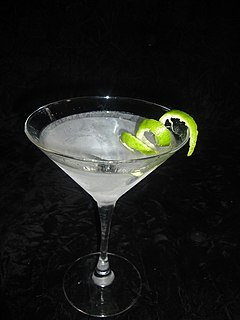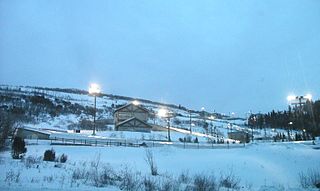
New England cuisine is an American cuisine which originated in the New England region of the United States, and traces its roots to English cuisine. It is characterized by extensive use of seafood and dairy products, resulting from its historical reliance on its seaports and fishing industry, as well as extensive dairy farming in inland regions.

The martini is a cocktail made with gin and vermouth, and garnished with an olive or a lemon twist. Over the years, the martini has become one of the best-known mixed alcoholic beverages.

A cosmopolitan, or informally a cosmo, is a cocktail made with vodka, triple sec, cranberry juice, and freshly squeezed or sweetened lime juice.

A chocolate brownie or simply a brownie is a square or rectangular chocolate baked confection. Brownies come in a variety of forms and may be either fudgy or cakey, depending on their density. Brownies often, but not always, have a glossy "skin" on their upper crust. They may also include nuts, frosting, cream cheese, chocolate chips, or other ingredients. A variation made with brown sugar and vanilla rather than chocolate in the batter is called a blond brownie or blondie. The brownie was developed in the United States at the end of the 19th century and popularized there during the first half of the 20th century.

A cocktail glass is a stemmed glass with an inverted cone bowl, mainly used to serve straight-up cocktails. The term cocktail glass is often used interchangeably with martini glass, despite their differing slightly. Today, the glass is used to serve a variety of cocktails, such as the martini and its variations, Manhattan, Brandy Alexander, pisco sour, Negroni, cosmopolitan, gimlet, and the grasshopper.

A vodka martini, also known as a vodkatini or kangaroo cocktail, is a cocktail made with vodka and vermouth, a variation of a martini.

The gimlet is a cocktail made of gin and Rose's lime juice. A 1928 description of the drink was: gin, and a spot of lime. A description in the 1953 Raymond Chandler novel The Long Goodbye stated that "a real gimlet is half gin and half Rose's lime juice and nothing else." This is in line with the proportions suggested by The Savoy Cocktail Book (1930), which specifies one half gin and one half lime juice. However, modern tastes are less sweet, and generally provide for at least two parts gin to one part of the lime and other non-alcoholic elements.

Various unique terminology is used in bartending.

"Shaken, not stirred" is how Ian Fleming's fictional British Secret Service agent James Bond prefers his martini cocktail.

The Vesper or Vesper Martini is a cocktail that was originally made of gin, vodka, and Kina Lillet. The formulations of its ingredients have changed since its original publication in print, and so some modern bartenders have created new versions which attempt to more closely mimic the original taste.

The Utah Olympic Park Track is a bobsleigh, luge, and skeleton track in the United States, located in the Utah Olympic Park near Park City, Utah. During the 2002 Winter Olympics in nearby Salt Lake City, the track hosted the bobsleigh, luge, and skeleton events. Today the track still serves as a training center for Olympic and development level athletes, and hosts numerous local and international competitions. It is one of two tracks in the nation, the other is at Mt. Van Hoevenberg near Lake Placid, New York.

An ice bar, sometimes associated with an ice hotel, is a drinking establishment primarily made of ice. The bars usually contain ice sculptures and other formations and are kept at low temperatures to hinder melting. The walls and seating are also usually made of ice. Mostly a novelty, the ice bar is often considered a tourist destination. Visitors enter for timed stays and even staff work on time-limited shifts. The most popular drinks served at ice bars are ice-cold vodka shots, or cocktails mixing vodka with a berry puree.

A Bacon Martini, also known as bacontini, pig on the rocks or a bloody bacon martini, is a cocktail that consists of bacon-infused vodka served with a garnish that can include strips of bacon, bacon bits, or olives. Variants may include the addition of Bloody Mary mix. Although not a vodka martini, which consists of vodka and vermouth, the term "bacon martini" is consistent with the trend of calling any straight liquor in a martini glass a "martini," such as the saketini or other variations.

A BLT cocktail is a cocktail made out of the contents of a BLT sandwich,, blended together with vodka. Variants on the drink include utilizing bacon vodka instead of traditional vodka, substituting liquor for lettuce, incorporating bacon salt, or including cucumber flavored vodka.

A lemon drop is a vodka-based cocktail that has a lemony, sweet and sour flavor, prepared using lemon juice, triple sec and simple syrup. It has been described as a variant of, or as "a take on", the Vodka Martini, but is in actual fact a closer to a White Lady variant. It is typically prepared and served straight up – chilled with ice and strained.
An astro pop cocktail is a layered cocktail, mixed drink or shooter so named because it resembles the Astro Pop lollipop candy brand. Various recipes exist that use liquor and liqueurs to produce the drink. A version of the drink exists that is layered with red, white, and blue colors and served in a shot glass. It is a popular alcoholic beverage in some drinking establishments.

The espresso martini is a cold caffeinated alcoholic drink made with espresso, coffee liqueur, and vodka. It is not a true martini as it contains neither gin nor vermouth, but is one of many drinks that incorporate the term into their names.



















